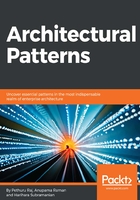
An example of n-tier architecture (shopping cart web application)
We can illustrate the working of an n-tier architecture with the help of an example of a shopping cart web application which is present in all e-commerce sites. The shopping cart web application is used by the e-commerce site user to complete the purchase of items through the e-commerce site.
Hence, the application should have several features which enable the user to do activities like the following:
- Adding selected items to the cart
- Changing the quantities of items in the cart
- Making payments
The client tier, which is present in the shopping cart application, interacts with the end user through a GUI. The client tier also interacts with the application that runs in the application servers present in multiple tiers. Since the shopping cart is a web application, the client tier contains the web browser. The presentation tier present in the shopping cart application displays information related to the services like browsing merchandise, buying them, adding them to the shopping cart, and so on. The presentation tier communicates with other tiers by sending results to the client tier and all other tiers which are present in the network.
The presentation tier also makes calls to database stored procedures and web services. All these activities are done with the objective of providing a quick response time to the end user. The presentation tier plays a vital role by acting as a glue which binds the entire shopping cart application together by allowing the functions present in different tiers to communicate with each other and display the outputs to the end user through the web browser.
In this n-tier architecture, the business logic which is required for processing activities like calculation of shipping cost and so on are pulled from the application tier to the presentation tier. The application tier also acts as the integration layer and allows the applications to communicate seamlessly with both the data tier and the presentation tier. The last tier which is the data tier is used to maintain data. This layer typically contains database servers. This layer maintains data independent from the application server and the business logic. This approach provides enhanced scalability and performance to the data tier.